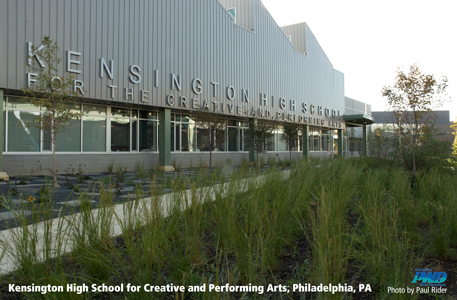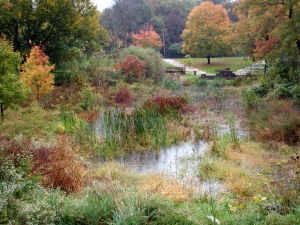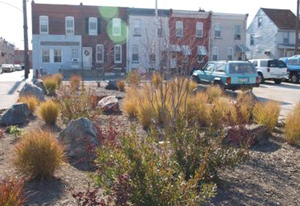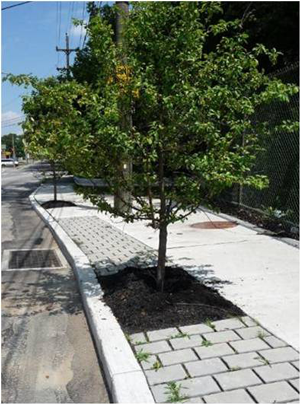Community Input For Green Stormwater Infrastructure
Step 2 of 5: Project Types
PWD is seeking input on potential green stormwater infrastructure projects on the following types of sites:
Schools

- Schools that are seeking green projects on their property and have support from the principal, teachers and/or parent associations. It is beneficial if teachers at the school are interested in incorporating green infrastructure into their curriculum.
- Schools must contain available open space to serve as a location where green infrastructure such as trees, rain gardens or stormwater planters can be developed.
- For an example, view the Penn Alexander School GSI project
Parks and Recreation Centers

- New, planned or existing parks where park designers and park users would like to incorporate stormwater management features. For an example, view the Saylors Grove GSI project (pictured right).
- Recreation centers that are seeking green projects on their property. For an example, view the Waterview Recreation Center GSI project.
- Parks or recreation centers must contain available open space to serve as a location where green infrastructure such as trees, rain gardens or stormwater planters can be developed.
Parking Lots

- City-owned parking lots with underutilized space that could be used for green stormwater infrastructure.
- For an example, view the Eadom Street Parking Lot GSI project (pictured right).
Public Spaces

Traffic Circle or Triangle
- An existing traffic triangle or circle or an unused portion of oversized sidewalk that could be greened without disrupting the flow of traffic.
- The traffic circle or triangle must contain a stormwater inlet.
- For an example, view the Traffic Triangle at 47th St. and Grays Ferry GSI project (pictured right).
Vacant Lots
- Vacant lots must not contain structures and be otherwise unused by the current owner.
- Vacant lots can be private or city-owned.
- Small and/or oddly-shaped lots that are not otherwise suitable for new development are of highest interest to PWD.
- Vacant lot projects must have support from nearby residents and civic organizations for construction of a green infrastructure project.
Community Gardens or Community Parks
- A community-run garden or park established on a vacant lot.
- Must contain significant open space that can be used as a location where green infrastructure such as trees, rain gardens or stormwater planters can be developed.
- Must have support from the landowner, surrounding community and users of the garden or park for construction of a green infrastructure project.
Public Plaza
- An outdoor space owned and utilized by a city agency that does not fit into the category of park or recreation center, where there is significant open space in which green infrastructure such as trees, rain gardens or stormwater planters can be developed.
- Must have support from the city agency utilizing the plaza for construction of a green infrastructure project.
Green Streets

- Public streets and intersections can be suggested for greening by civic groups, business improvement districts or other community organizations.
- Streets and/or intersections that have been prioritized by the community for greening are ideal candidates.
- Streets and/or intersections that are overly wide and could benefit from traffic calming and pedestrian safety features such as bumpouts are ideal candidates.
- Green streets projects face a number of design constraints. Projects that meet the following criteria will be more likely to be selected for a GSI project:
- Wide sidewalks (greater than five feet).
- Buildings are set back from the street by more than five feet.
- No street trees (or dead or unhealthy street trees in need of replacement).
- Street is flat, not sloped.
- Street contains a small number of individual parcels or buildings. (Green streets projects are difficult in dense residential or commercial areas due to utility conflicts underground.)
Here are additional resources that communities can use to green their streets:
- Tree Philly: Request street trees or report street tree problems.
- Pennsylvania Horticultural Society Tree Tenders: Learn to care for trees in your neighborhood and request trees for your community.